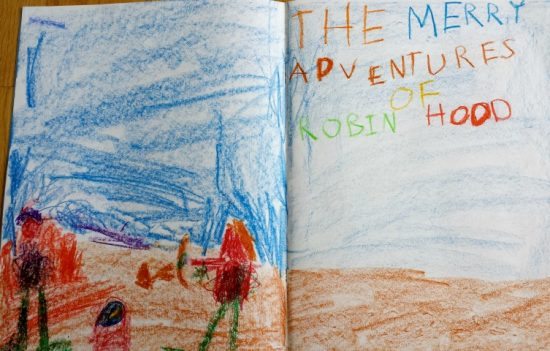When I helped my oldest child create his first main lesson book almost 25 years ago, I was totally intimidated. The intention behind a main lesson book is an artistic experience that becomes an alternative to the dry and abstract writing found in textbooks.
The main lesson book itself is a collection. A student’s best work, a summary of lessons on a particular subject – all shared through the child’s own words and drawings. It may contain stories, descriptions, observations, experiments, or poems. It’s a book that your child can come back to and review at the end of the year and reflect on their experience and growth.
So when it came time for this to happen in my home, I wanted to control what my son drew and wrote in his main lesson book.
So that it looked just like a Waldorf main lesson book was supposed to look.
Except I’d never seen a real main lesson book before.
Hmmm… That’s problematic. So how was I to know what we were even aiming for?
Then later, after I visited the nearest Waldorf school and saw the main lesson books that the children were creating there, the intimidation and “not good enough” feelings grew in full force.
I was facing my own perfectionism. And this was even BEFORE Pinterest.
So which is worse? Not knowing at all what a main lesson book should look like? Or seeing someone else’s books and creating an impossibly lofty goal to aim for?
These days, it’s rare to find someone who’s never seen a main lesson book at all. We have Facebook, and Pinterest, and blogs, and Instagram to thank for that. And then comparisonitis sweeps in.
Since those early years, what I’ve found most helpful of all is to read Rudolf Steiner’s words about creating “good books” as a way for our children to record their learning.
Steiner said that we want to engage each child’s imaginative forces. To have them bring forth their own connection to the story material presented to them. Main lesson books seal the learning that has taken place.
“All teaching is drawn from the artistic realm, where creative life is at the core of all experience. The whole method with which we approach the child must be steeped in artistry, that is, it must be imaginative, living, colorful, immediate, engaging.” ~Rudolf Steiner, Practical Advice to Teachers
What a joy to see our children truly engaging in the stories. To see their face light up when they show us their drawing and say, “Do you see this fox? He’s trying so hard to jump up to get those grapes but he never reaches them!”
Here are a few samples from my children’s main lesson books. They are not always neat and pretty, but they do represent lots of learning going on!
The intention behind these books is to “combat the abstract.” And that they do. Main lesson books bring the learning alive for children.
These books are theirs, not ours.

So really, this whole main lesson book process isn’t about how the books look. It’s about the learning that happens while our children are making the books.
I’ve had to learn to set aside my own perfectionism so that my children can create main lesson books that are just right for them.

If you want to hear more about creating main lesson books and setting up main lesson blocks, check out my 5-post series starting with What Is a Main Lesson Block? Another of the posts in the series is all about recording the learning in main lesson books.



Oh my goodness. I really heard you with this. When we did our first main lesson book the urge to tell my son how to do it was extreme. I wanted to dictate the drawing and the writing. I wanted the book I’d create. He is a strong willed little man and went his own way as usual including doing some pages upside down. We revisited that book recently and he flipped through the pages full of joy, recounting the stories and the adventures he had through his learning.
Thank you so much for sharing this.
Oh, I love this Marianne! You are not alone. I think we all experience this to some extent. But what a joy to hear your son recounting his learning adventures. And they are his! ?